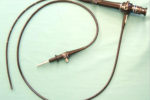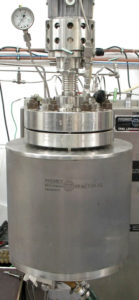Use of cookies
Cookies help us to provide our services. By using our website you agree that we can use cookies. Read more about our Privacy Policy and visit the following link: Privacy Policy
There are more than 400,000 medical devices which cannot be sterilised using conventional steam sterilisation (121/134 °C), for example, flexible endoscopes which are inserted into the aseptic visceral cavity. Polymers used for the production of these medical devices are often thermolabile and must not be exposed to temperatures above 60 °C. However, they are subject to stringent hygiene requirements. Currently used sterilisation methods are technically demanding and have considerable disadvantages with respect to process time, safety or material damage.

The aim of the project SteriScope was shared in two respects: on the one hand, a novel low-temperature sterilisation procedure for thermolabile geometrically complex medical devices, such as flexible endoscopes, was developed using highly compressed supercritical carbon dioxide (SCCO2). On the other hand, the polymer used for the production of medical devices needs to be compatible with this method of sterilisation, therefore a novel polymer material was developed that answers to the product requirements and the sterilisation method.
During the research and development process, relevant factors, which have an influence on the antimicrobial effect of SCCO2, have been characterised and optimised. Using an additive combination, the inactivation efficacy of microorganisms was enhanced, so that a suitable process for the sterilisation of medical devices could be developed. The process is based on the treatment of SCCO2 at pressures of 80 to 90 bar and at temperatures between 37 °C and 40 °C. However, such SCCO2 processes lead to massive damage or destruction of the majority of polymers used for the construction of present types of flexible endoscopes. Hence, in parallel, novel polymer materials for the manufacturing of future medical devices were developed. A total of 62 nanocomposites were manufactured. For this purpose, base polymers, which were already used for the construction of medical devices, were modified by incorporation of different degrees of nanoscaled fillers. Four of these new nanocomposites were totally compatible with the developed SCCO2 process and showed no adverse alterations, even after repeated treatment cycles. These materials proved to be particularly suitable.

Reprocessing service providers, central sterilisation service staff, operators and users of devices, physicians as well as patients of the 20,000 hospitals and 500,000 medical practices within the EU will benefit from the project results. Further beneficiaries are manufacturers of medical devices. The medical technology industry in the EU comprises of about 62,000 companies with 420,000 employees and has an annual turnover of approximately € 52.6 billion. The industry is mainly composed of small and medium sized enterprises (~ 80%). The developed new nanocomposites will be applied by medical technology companies to the evolution of new generations of medical devices. Further, the new sterilisation method is highly relevant for reprocessing service providers. The sector of professional cleaning/hygiene services in the EU includes over 103,500 companies with annual sales of € 51.2 billion. These companies get the opportunity to offer treatment services faster and cheaper. By the use of the developed sterilisation method, the process times are shortened and the possible risks to patients and staff are reduced. Furthermore, liability risks due to material damage are minimised. Nanocomposites allow the development of new generations of medical devices with special properties. In 2015, the demand for nanocomposites was more than 500,000 tons. By 2025, a demand volume of about 5 million tons is expected, with a market volume of € 20 billion. A steadily growing proportion is used in medical instruments. The project results are of such great interest to the medical technology sector that renowned medical device manufacturers have already proceeded with internal research and development work on SCCO2 sterilisation.
European Cleaning and Hygiene Technology Research Association e.V. (FRT), Dr. Jürgen Bohnen, Tel: +49-2151-778042, info@frt.de
FRT – European Cleaning and Hygiene Technology Research Association e.V. – association
wfk – Cleaning Technology Institute e.V. – researcher
COG OOE – Clusterland OOE GmbH, Gesundheits-Cluster – association
MUL – Lehrstuhl für Kunststoffverarbeitung, Montanuniversität Leoben – researcher